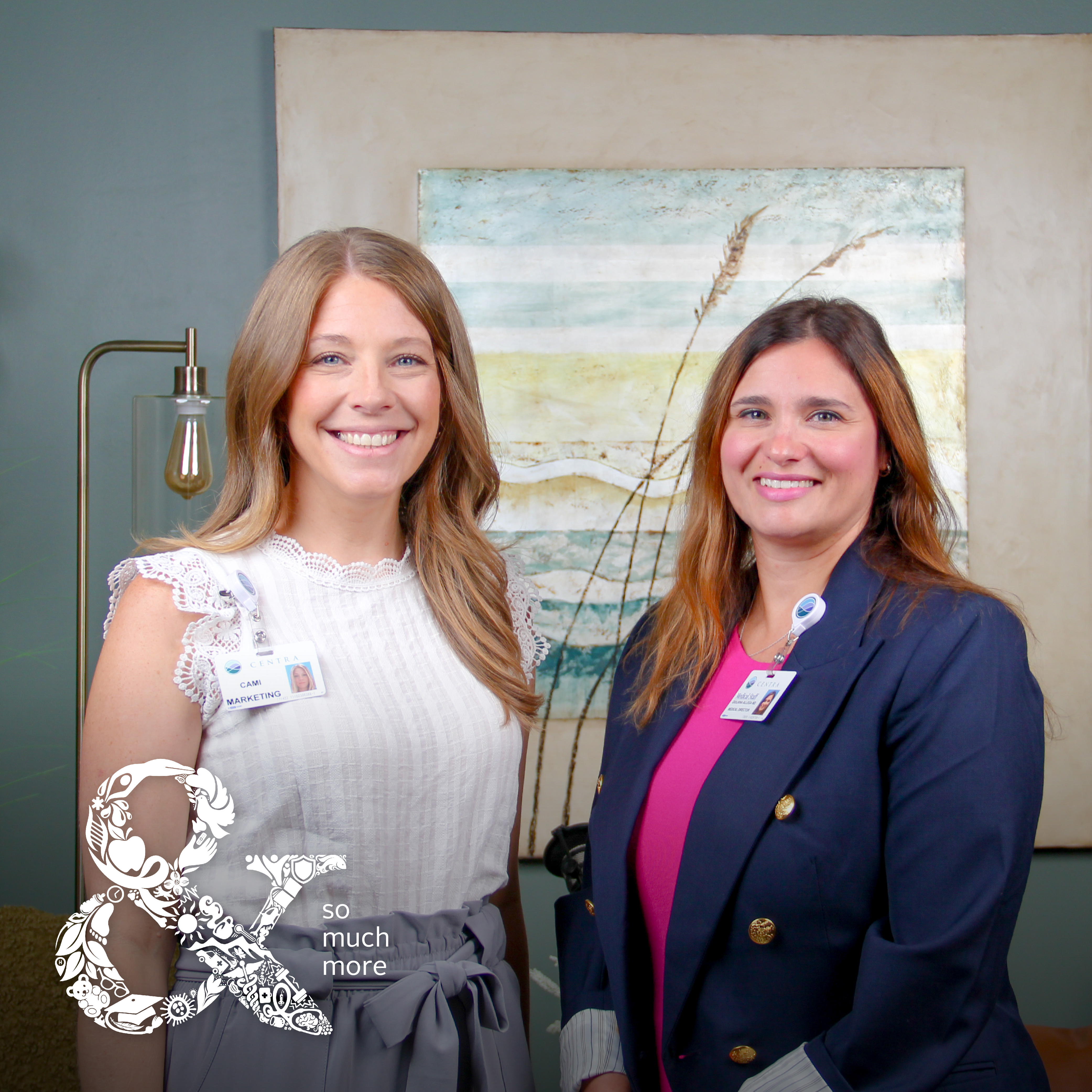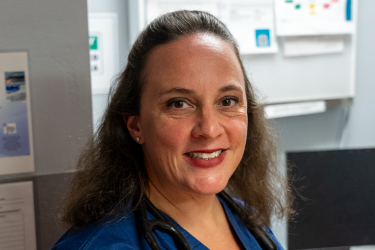In a world where healthcare can often feel impersonal and fragmented, this episode of & So Much More paints a vivid picture of how Centra is reshaping the narrative! Join Cami Smith and Dr. Giuliana Allega, a primary care provider and the Director of Ambulatory Care at Centra as they discuss what the care team approach is and why this model of care allows Centra to serve its patients better.
Together, Dr. Allega and Cami discuss concerns that patients can have when being seen by multiple providers and dispel common misconceptions about the care team model.
They explain that with the care team approach constant communication and close working relationships are prioritized which means patients can trust that there is a dedicated team by their side working together to deliver excellent care.
Watch on YouTube
Transcript
Cami Smith:
Hi, and welcome to & So Much More. My name is Cami Smith, and I'm your host, and I'm here with Dr. Allega, who is the Medical Director of Ambulatory Care here at Centra. And we hear ambulatory care, and I think those who are listening may have zero context for what that is. So how would you explain what ambulatory care covers, like that umbrella?
Guiliana Allega:
Yeah. So ambulatory does mean something that happens in the outpatient setting. The ambulatory care service line here at Centra is composed of our entire primary care services, urgent care, Lynchburg Family Medicine Residency Program, Home Health Hospice, and palliative care. So it's really the front door and the interface with the community, which is super exciting.
Cami Smith:
Well, and probably what most people are most well-versed on, they're most knowledgeable, or if not knowledgeable, they at least know primary care is a necessity. So that's very cool. That spans a lot. So what does your day-to-day look like? That's a big responsibility.
Guiliana Allega:
It is a big. Yeah. So I am a primary care physician and I'm coming up on my six-year anniversary with Centra. And I started out in Farmville and I still have my patient panel there seeing them. So I do that two half days a week. And then in addition to that, I am collaborating with many different people and we are trying to fix problems and innovate to try to make things better for our people, our workforce, and our patients, of course.
Cami Smith:
And something that I love so much about Centra, and this might be true of many health systems, but our community are our caregivers. So it's such a great place to be because when you're pouring into your caregivers, you're also pouring into your community and vice versa and it's so important to really prioritize both. Well, I'm really glad that you're able to be here with us. We're talking about the care team approach, and I'm going to put this pen down because I keep making noise with it. So I'm going to get that over there.
Guiliana Allega:
It looks like a good pen.
Cami Smith:
It's a good pen. So we're talking about the care team approach, and this really does play a big role in primary care because when you're coming in and you are seeing your primary care physician, whether that is a DO or an MD or an NP or something under the APP umbrella, which we've talked about in this series, I think that most people are still a little elusive of who are all these people that I'm engaging with because you come in and you interact with multiple individuals for one visit. So I think it's just so important to give people a little bit of a more well-rounded understanding of who are these people? How are they playing into my care? Are they just passing in? Are they just taking my blood pressure and moving on? So what can you tell us about the care team approach?
Guiliana Allega:
The care team approach has been around for a while, and it really is a new way of thinking about care delivery for both the people that are delivering the care and the patient. So it's very patient-centered. And we're really seeing a movement away from the one doctor/one patient relationship, which is a very important relationship, and spreading out those responsibilities among a whole care team. And as you mentioned, yes, there is a physician on the care team, there might be a physician assistant, a nurse practitioner, but there's also other members of the care team in our primary care offices.
So those could be people that are pharmacy technicians that help with your prescription refills. They may help with discount programs for drugs, which is a really important function that they serve. We also have some licensed clinical social workers that help with mental health counseling, and they work really closely with our behavioral health teams. We want to eventually have diabetic educators within all of our primary care offices, and they would serve a really important function. We have our licensed practical nurses, our LPNs and MAs, which help us with other clinical tasks like making sure we get the patient roomed performing any kind of EKGs, immunizations, point of care testing.
When you're at the doctor's office, the nurse may do a strep test on you. So there really is a lot of members of the care team that can assist with all the things that it takes to take care of a patient. And for the patient, it really is more than one person looking after you. So that's awesome, I think.
Cami Smith:
Yeah. So how would you encourage someone from the community to educate themselves on what all of these different types of providers are because that's a lot. It's a mouthful when you think about-
Guiliana Allega:
Yeah, it's a whole menu.
Cami Smith:
... licensed clinical social worker, LPN, but it's important. It's important to know who is providing you care. So I'm just curious, how do you advise your patients to educate themselves?
Guiliana Allega:
My patients know that I work with a care team at Centra Southside Medical Center, so they come to me as their primary care provider, but there may be days and there is days when I am not seeing patients in the office. So they may be able to see one of our wonderful APPs, I'm going to give them a shout-out, Alison Lee and Gabriela Graybill at Southside. They do a wonderful job.
So they're able to see the patients if I'm not there, if there is things that they need to be seen acutely for, maybe they've got a cough or a cold, poison ivy, or they need a quick preoperative clearance for their cataract surgery. There's many, many things that the physician assistants and nurse practitioners assist with. But not only do they assist the physicians in primary care, those providers also carry their own patient panels. So they are responsible for entire panels of patients that can be upwards of about 1,500 patients.
Cami Smith:
Oh my goodness.
Guiliana Allega:
So they do a big job and they work really, really hard. All our providers work really, really hard. I'm very proud of them.
Cami Smith:
I love that. So what does that working relationship look like, for my own curiosity, between you and your team? You have to work really closely with, especially these APPs if you're sharing this patient and you both want to be that incredible source of care for them. So what does that look like?
Guiliana Allega:
That's a really good question, Cami, because often the patients have that question, "If I see someone else, how am I going to know that they spoke with you or discuss my care with you?" And I assure the patients that we're working, usually, in the same hallways, the same facilities, the same pods. We have pods in the offices where we work with entire teams of providers and nursing staff. And if they're seeing a patient and they have a question, and I'm maybe in Lynchburg that day and they're in Farmville, they can just call me and we talk about what the next step is if they have a question, if it's a more serious issue. So it's a very close working relationship. It really is a collaboration.
Cami Smith:
Yes. And that's why I think it's so important for, I say us because I think of myself as a patient, to really look at your primary care experience, but also your specialty care experience as a care team. You have a team that is collaboratively talking about how to best provide you care. And that's actually pretty cool when you think about it, that there are multiple people putting their minds together and their expertise and their experience for you. It's a resource.
Guiliana Allega:
And these care teams exist really in a lot of different service lines within the medical group; cardiology, oncology, and nephrology. So there's a lot of places where we use this model.
Cami Smith:
So what is one thing you would like our community, our patients, to know if they're feeling apprehensive about this? And maybe it is something that we've already covered and you can elaborate on, but I think about there is a part of our community who have had one primary care provider their entire life, so this is a big jump, but how do you ease that apprehension?
Guiliana Allega:
Yeah. I think it's about developing trust, like any relationship, and meeting the provider and just knowing the care team. So we are doing a lot of work right now, you as our marketing team are helping us with that, to help educate on what roles the care team serves, who is in the care team. I think it's really helpful sometimes to know who everyone's role is and what their name is and who you may encounter when you're walking into the office. But not only when you come into the office, you're seen when you leave, you're going to get follow-up as well. And then all of those providers can coordinate to make sure that they're doing what's best for you.
We are doing a lot of work recruiting all these care team members. So the ambulatory care service line is working very hard to recruit pharmacy technicians, physicians, APPs, nurses, our front desk staff, our medical office assistants. So we are all in to try to make this the best possible experience for the patients. And then we're also really looking at models of care in terms of finances and moving forward from a fee-for-service to more value-based care.
So really providing value to the patients, which means providing the highest quality of care at the lowest cost. And I think that's something everybody wants.
Cami Smith:
Yeah, everyone's ears just perked up when they heard the highest care at the lowest cost. Mine did though. When you think about, "I have a family of four," some people, a family of 5, 6, 7, you want what is best for your family, but sometimes you're limited by your resources. So I think to have a health system that works with you in that way is so important. Well, I love that. And something I do want to encourage our listeners to do, and I do this, but working here, I think I want everyone to know this little trick, so go to our website, centrahealth.com, and click on providers at the top of that page, and it's just on our main menu, and you can look up your providers. You can see what some of their hobbies are. You can see what they look like, you can see where they went to school, their credentials, where they provide care.
And I think that's really important for people to maybe feel at ease If you're going in. If you see someone come in who's not your primary care provider, but it's a part of your care team, they are taking the time to get to know you. So you have this opportunity to get to know them as well. So I know that's something that we're trying to be really intentional about building up on our site as a resource for the community. So go and do that, but then ask the questions. I think that as you come into your appointment and you want to know who these people are, we're going to do our best to get this information out for you, but also ask the questions. Excuse me. This team is here for you, so your questions are valued and they're important. But thank you so much Dr. Allega, for being here.
Guiliana Allega:
Yeah, thanks for having me here. This was fun.
Cami Smith:
I'm glad. And thank you guys for listening. We hope you'll join us next time on & So Much More.




